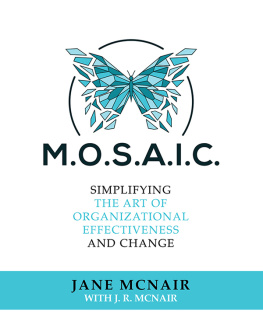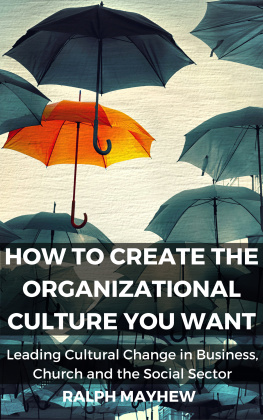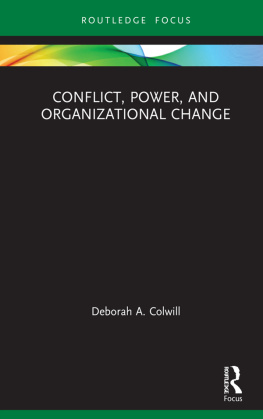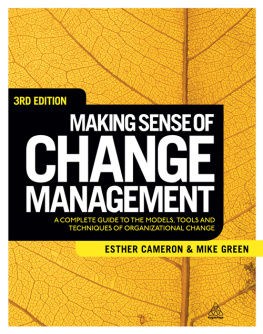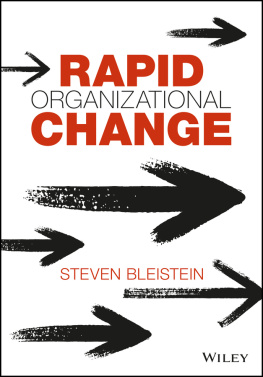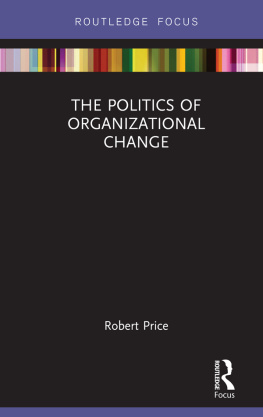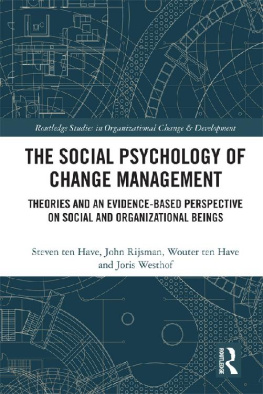Table of Contents


Charleston, SC
www.PalmettoPublishing.com
M.O.S.A.I.C.:
Simplifying the Art of
Organizational Effectiveness and Change
Copyright 2022 by Jane McNair and J.R. McNair
All rights reserved
No portion of this book may be reproduced, stored in a retrieval
system, or transmitted in any form by any meanselectronic, mechan
ical, photocopy, recording, or otherexcept for brief quotations in
printed reviews, without prior permission of the author.
First Edition
Hardcover ISBN: 978-1-68515-885-9
Paperback ISBN: 978-1-68515-886-6
eBook ISBN: 978-1-68515-887-3
Dedication
To those who have the courage
to speak the truth to power
for they can change the world
Table of Contents
I have had the good fortune to work with some incredibly skilled organizational effectiveness and change management professionals over the course of my career. My work and the content of this book has been influenced by them all. I wish to express a special thanks to Pat Cramer. Your wisdom and support were the catalyst for my career, and I wouldnt be where I am without youyour friendship is a gift I have always cherished. To Sandy Catalani, who tirelessly responded to any request for support regardless of how ridiculous it may have sounded at the timeyour ability to see what I needed before I knew I needed it was never taken for granted. Id like to particularly thank Vicki Poels, Paul Turner, Petra Schennach, and Michele Grisez who both read sections of the manuscript and contributed invaluable feedback. Vicki, your creative insights and support throughout this journey was invaluableI am eternally grateful for your willingness to challenge my thinking and contribute to it. Id also like to thank my many clients, both internal and external, who have prompted my thinking on these topics and challenged me to always view my work through the eyes of the client. Finally I would like to thank my wonderful husband of thirty-eight years, Bob, who has always served as a reliable sounding board and willing test subject. You are my rockanother thirty-eight years still wouldnt be enough time with you. My amazing sons, Mark and Jay, who have for years tolerated all the global travel that has made my work possible. Jay, your ability to bring fresh thinking to old concepts as we worked on this book was invaluable. To my parents, Kathleen and Jerry Durkin, who continue to watch over me. Thank you for giving me the confidence to venture into unfamiliar placesit serves me well in this field of work. I am deeply grateful to all of you.
Have you ever invested an exorbitant amount of time and energy on a project, believing that it needed to be perfect, only to see it fail? Early in my career, I was presenting to the senior vice president of marketing for a large financial organization. Five minutes into my presentation, I knew I was in trouble. All my carefully worded and politically correct slides describing the problem and possible solutions werent hitting the mark. My boss, who had accompanied me to the meeting, moved her chair back, distancing herself from my imminent failure. My planned hour-long meeting was done in ten minutes. As we rode the crowded elevator from the executive suite back down to our departmental floor, she turned to me before exiting and said,If you cant look an executive in the eye, tell him in simple language that he is about to screw up and have some practical ideas to keeping him from doing that, you dont belong in this business. I still remember the looks of pity from total strangers in that elevator. It was one of the most embarrassing but defining moments of my professional career.
That early and painful lesson taught me the value of simplicity. Whether it is diagnosing the problem, framing the conversation, or pinpointing the most critical inhibitors to success, you must keep it simple. Clients repeatedly tell me, Your tools make it so simple. Cant you put it in a package for us? This frequent request is the impetus for this book.
Organizational effectiveness (OE) is the measurement of how successfully an organization reaches its goals. There are hundreds of books and suggested processes available on OE and change management. Most of them fall into two categories. First there are those that focus primarily on the softer side of change, such as overcoming resistance and/or techniques that entice employees to adopt a change. Although these are important concepts to keep in mind, we have found that the most significant part of enticement is grounded in the organizations ability to quickly crystallize what needs to be accomplished and clearly outline the plan to accomplish it, yet that continues to be a challenge for many organizations. Then there are those publications that are theoretical in nature and/or focus solely on a single component of OE, such as strategy, organizational redesign, talent management, process improvement, culture, et cetera. These publications make important contributions because they explain the principles underlying the tools and practices recommended on the following pages, but are often presented with such complexity that it is paralyzing for those who are tasked with implementing change rather than studying it. This book is different. The MOSAIC change approach is not focused on the theoryit is all about the what and the how.
MOSAIC provides an easy-to-use framework for identifying and resolving the most common internal obstacles that limit organizational effectiveness and impact the organizations ability to drive change. It is intended as a practical field guide. It is for the leader who does not have the luxury of having an OE professional on staff to help resolve and work on change issues, for the entrepreneur who needs some basic guidance on how to get a launch plan in place, and for the human resource leader or OE professional who is looking to expand their tool kit. My goal is to provide the reader with the same tools that I have successfully used as both an internal and external consultant.
There is only one chapter in this book that I encourage you to read fully. Chapter 1, Introduction to the MOSAIC Change Framework, establishes the structure for the entire book. When people ask me how to think about OE work, this is the mental model I use. There are two significant elements of organizational effectiveness and change that are not reflected in traditional organizational models: the need for strong project management and the adherence to basic change management principles. Without these two elements, I can all but guarantee that your change efforts are likely to fail; therefore these are important parts of the MOSAIC change framework.
Having a conceptual understanding of each MOSAIC element and approaching the whole is how you can most effectively manage and integrate the parts of any change. This will also allow you to make the most use of each subsequent chapter and enable you to match the tools with specific problem areas in your own organization. The use of tools without a broader understanding of the organization as a system can prevent you from focusing on your root-cause problems, so dont skip this chapter!
Once youve read chapter 1, feel free to skip around from topic to topic. Devoting time and organizational energy to issues that are

